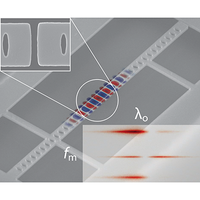Abstract
Dissipative and dispersive optomechanical couplings are experimentally observed in a photonic crystal split-beam nanocavity optimized for detecting nanoscale sources of torque. Dissipative coupling of up to approximately 500 MHz/nm and dispersive coupling of 2 GHz/nm enable measurements of sub-pg torsional and cantileverlike mechanical resonances with a thermally limited torque detection sensitivity of in ambient conditions and in low vacuum. Interference between optomechanical coupling mechanisms is observed to enhance detection sensitivity and generate a mechanical-mode-dependent optomechanical wavelength response.
- Received 25 March 2014
DOI:https://doi.org/10.1103/PhysRevX.4.021052
This article is available under the terms of the Creative Commons Attribution 3.0 License. Further distribution of this work must maintain attribution to the author(s) and the published article’s title, journal citation, and DOI.
Published by the American Physical Society
Popular Summary
In recent years, optical cavities—wherein light follows a closed path—have proven to be remarkable tools for nanoscale experiments. Cavity optomechanics uses light to measure and control the motion of optical resonators. By amplifying the interaction between light and mechanical vibrations, cavity-optomechanical sensors have recently enabled unprecedented sensitivity in measuring minute displacements of on-chip devices. These sensors can be used for detecting environmental stimuli such as acceleration, measuring small fields, and sensing particles, which have applications in diverse areas of physics and engineering. We describe the fabrication and optimization of an optomechanical sensor for detecting small amounts of torque using dissipative coupling, a new effect that has been discussed theoretically but has not—before now—been used for torque sensing.
Optomechanical sensors generally rely on dispersive coupling, in which the displacement of the mechanical device changes the wavelength of its optical resonance. This signal is amplified by the cavity before being transmitted to the output. In our case, we use an optical fiber to both input light into the device and collect the signal at the output. We use two nanomechanical resonators, which serve as optical mirrors that can move independently. Our device also allows its displacement to affect the length of time that light stays inside the cavity. Furthermore, the proximity of the optical fiber to the cavity plays a role by influencing how the light is transmitted. Both of these effects, collectively referred to as dissipative coupling, are imprinted on the output as an enhancement in the original signal. Using both dispersive and dissipative coupling effects, we have achieved an order-of-magnitude improvement in torque sensitivity in ambient conditions and in vacuum.
The record torque sensitivity exhibited by this device will be useful for studying magnetic materials and sensing magnetic fields. Furthermore, moving to the low-temperature regime will further increase the sensitivity of the nanocavity.



